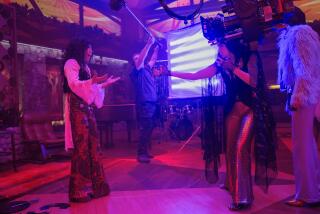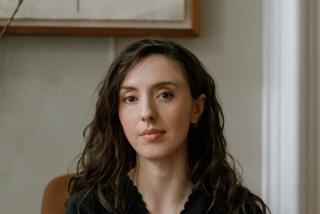Salem to Celebrate 300 Years of Witchery
- Share via
SALEM, Mass. — Here at the scene of the Salem Witch Trials, Halloween is the biggest holiday of the year.
Haunted Happenings, an 11-day annual event, culminates Wednesday when Laurie Cabot, Salem’s official witch, leads a candlelight procession to Gallows Hill where in 1692, 19 men and women were hanged for being witches.
The grim event is marked each year with such events as costume balls, a psychic festival, the retelling of mysterious legends in historic homes, and spell-casting workshops.
All year long, the drama of those frightful real-life witch trials is re-enacted daily with plays recounting the court proceedings and hangings. It all happens at the 1845 stone church converted into Salem’s Witch Museum.
“Welcome to the Witch Museum. Do you believe in witches? Millions of our ancestors did,” begins the Witch Museum narrator.
Business is also brisk this week at nearby Crow Haven Corner, a witchcraft shop named for the crow-filled pine tree nearby. Crystal balls, books of Tarot, magic wands and love potions are selling like hot cakes.
“People have come here this Halloween season as always from throughout New England,” said Alison Damario, Witch Museum education director. “But Salem is now preparing for a much greater, worldwide event--a yearlong solemn and dignified commemoration of the 300th anniversary of the Witch Trials.”
Tercentenary plans call for exhibitions, plays and lectures about Salem’s year of madness, hysteria and terror. Harvard University will hold a 1992 seminar about Increase and Cotton Mather, the father and son Puritan ministers, and the roles they played in the trials.
There will be 300th anniversary conferences here on 17th-Century theology, witchcraft literature, intolerance, and civil and human rights. An application has been made to the Post Office for a Salem Witchcraft Trials commemorative stamp. And a statue commemorating the trials has been commissioned. There also will be a choral production of “The Crucible,” Arthur Miller’s play about the trials.
Salem will be the site in 1992 of family reunions for descendants of the 19 persons hanged and of Giles Cory, 80, a convicted witch who was pressed to death beneath several tons of rock here.
Essex Institute, founded in 1821 as the official repository for Witchcraft Court transcripts, is researching now an exhibit on what life was like here at the time of the trial.
The logo for the Salem Witch Trials Tercentenary is a gravestone rubbing of a face flanked by the dates 1692 and 1992. Salem is a derivative of the Hebrew word shalom meaning peace. But there was little peace in Salem in 1692.
The madness began in the parsonage of Samuel Parris. There, Tituba, the family slave who was a native of Barbados, used stories of witchcraft to entertain the preacher’s 9-year-old daughter, Elizabeth, and his 11-year-old niece, Abigail Williams.
Shortly, both girls began acting strangely, uttering weird sounds, crawling on all fours and barking like dogs, staring blankly into space and writhing with convulsive fits. Dr. William Griggs was called to the parsonage and delivered his diagnosis: “They are under the spell of witchcraft.”
“Who is bewitching you?” demanded Parris. The girls said it was Tituba and two women already held in low esteem in the community.
Thus began the infamous inquisition. Before it was over, more than 400 persons were accused of being witches, 150 were jailed, 14 women and five men hanged, and poor Giles Cory crushed to death.
At least three women and a baby died in prison. Several pregnant women were jailed as witches. Among those hanged was the Rev. George Burroughs, a Harvard University graduate accused of being a witch.
A 5-year-old girl arrested for being a witch spent more than a year in jail before being released. Even a dog was killed for being a witch. The dog’s “evil eyes” supposedly sent his accusers into convulsions.
It was eight girls, aged 9 to 18, and five women who made all of the accusations. The entire volume of court testimony was based solely upon “spectral evidence” detailed by the accusers. The young girls and women made outrageous claims of witches tormenting and torturing them. And they alone were witnesses to the witches’ work.
The popular image of witches on brooms is derived from trial testimony of witches flying through the Salem skies on poles and sticks.
“I am as innocent as the child unborn,” Rebecca Nurse, 71, cried out during trial.
Despite a petition signed by 40 of her neighbors attesting to her exemplary character, Nurse was convicted of being a witch and hanged.
Her 17th-Century saltbox home is preserved in Danvers, five miles from Salem. Curtis White, 30, has lived in the Nurse home as caretaker for the last six years.
“No, the house is not haunted by Rebecca’s spirit, although some wish it were,” said White. Danvers is also the site of the Parris church and parsonage where the witchcraft hysteria began.
Richard Trask, 43, Danvers town archivist, is a direct descendant of five accused of being witches, including John Proctor and Mary Eastey, who were hanged.
“It is not unusual around here to have witches on the family tree,” allowed Trask.
Trask, who also chairs the Danvers Tercentenary Committee, showed a visitor an original church record book and opened it to 1692. There, written in the hand of preacher Parris, was the first known report of witchcraft that year:
“I think the devil has been raised against us and his rage is vehement and terrible and when he shall be silenced the Lord only knows . . ., “ wrote Parris.
The Danvers Archival Center and Essex Institute are the two best repositories of records and information on the Salem Witchcraft madness. Historical novels and scholarly books have been published about the event continuously since it happened. The interest lingers and, say historians, will not be put to rest.
“There are still many unsolved mysteries about the accused and the accusers of the trials, about so many things involved,” said Trask. “That’s what gives it its mystique. New writers keep showing up re-examining the event, always trying to mirror their generation, trying to understand it,” he said. “There will always be new theories, like the recent one, for example, that contaminated rye made the girls hallucinate.”
A permanent exhibit of witchcraft at Essex Institute features artists’ conceptions of three centuries of Salem witchcraft happenings, including the events described by the afflicted girls and women.
One display at Essex has a bottle with human finger bones found on Gallows Hill (now a city park) in 1900 and a fragment of a coffin dug up there in 1783.
One of the best known residents of present-day Salem is Laurie Cabot, 59, who has long black hair streaked with silver and always wears a black robe. In 1977, when receiving an award from Michael Dukakis for her work with dyslexic children, the governor proclaimed her Salem’s official witch.
Cabot heads the Witches League for Public Awareness. She also gives psychic readings. Her daughter runs the local witchcraft shop.
“I came to Salem to live 22 years ago to remind everyone that what happened in 1692 had nothing to do with witchcraft. It was pure hysteria, madness,” said Cabot.
“The Witches League for Public Awareness is not a frivolous fringe group to be made light of or ignored. Witchcraft is a legally recognized religion in this country, a nature religion. The Earth is our mother.”
Halloween, she said, is known to witches as “Samhain” and is celebrated as the witches’ new year. And where better to spend the holiday, said Cabot, than right here in Salem.
More to Read
Sign up for The Wild
We’ll help you find the best places to hike, bike and run, as well as the perfect silent spots for meditation and yoga.
You may occasionally receive promotional content from the Los Angeles Times.






